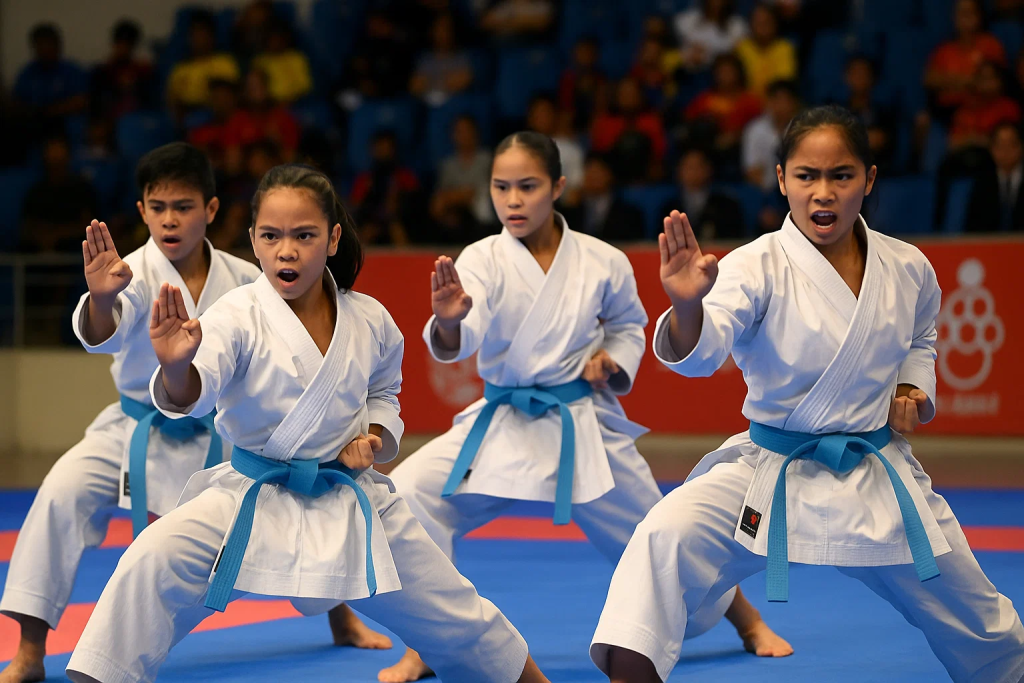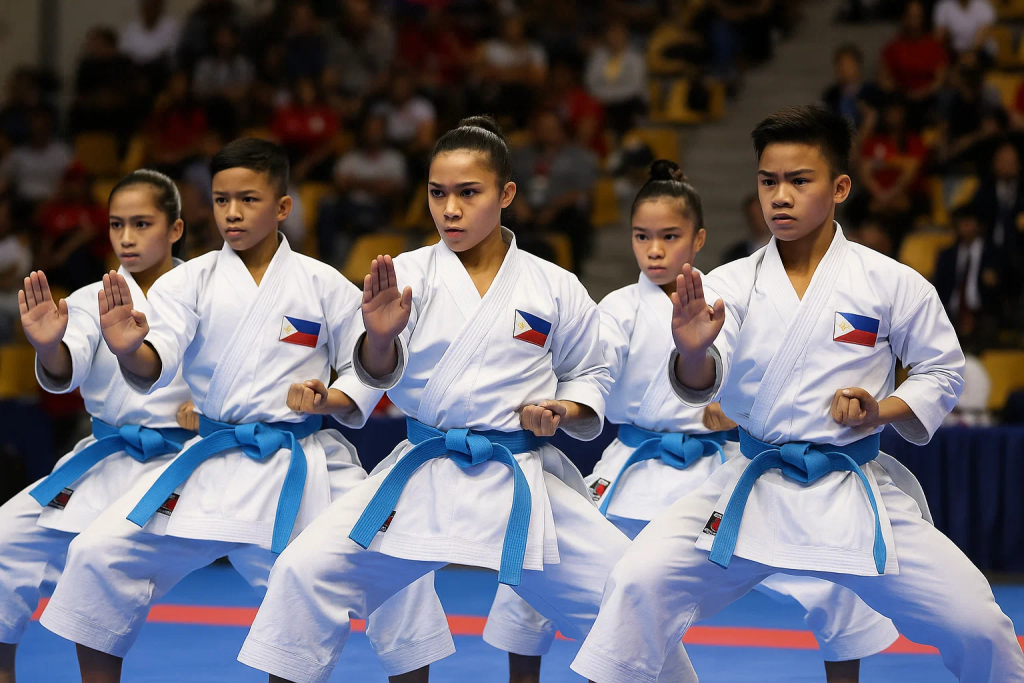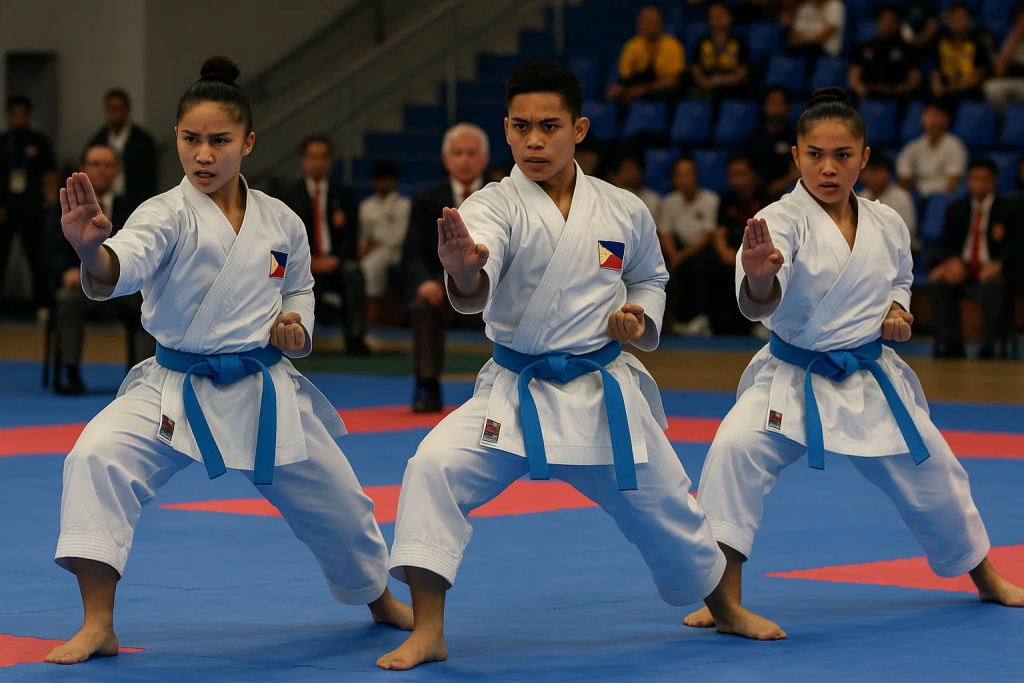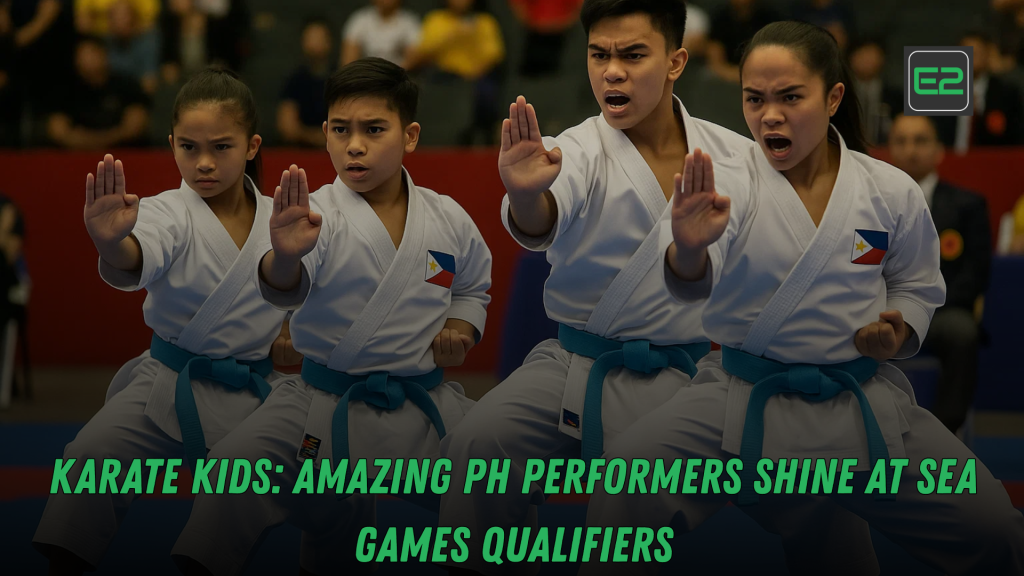Table of Contents
Executive summary
Philippine karate kids did more than show up at Southeast Asia’s most competitive youth stage—they won, learned, and built momentum for the 33rd SEA Games (Dec 9–20, 2025; Bangkok–Chonburi–Songkhla, Thailand). At the 12th Southeast Asian Karate Federation (SEAKF) Championships 2025 in Brunei, Team Philippines took 13 medals (1 gold, 1 silver, 11 bronze)—with Davao’s AZ Pamaybay clinching the lone gold in cadet kumite –57kg. These are predominantly cadet, junior, and U21 athletes: exactly the talent pipeline you want cresting into a SEA Games cycle.
Even better, karate is confirmed on the SEA Games program and assigned to Songkhla—a vital signal after last year’s concerns that Thailand might prune medal-rich sports. The SEA Games 2025 official site lists karate among Songkhla’s hosted sports, and updated program notes show karate (kumite and kata) included. Translation: our kids’ medals matter for 2025, not just as confidence boosts but as selection and seeding signals heading into the final push.
Below is a complete look at what happened at SEAKF, how Karate Pilipinas is structuring the pathway, what coaches and parents can do now, and how content creators and sponsors can support a surging, youth-led movement in Philippine karate.

Quick facts: SEA Games & SEAKF 2025
- SEA Games 2025: Dec 9–20, Bangkok–Chonburi–Songkhla, 50 sports. Karate events hosted in Songkhla.
- SEAKF 2025 (Brunei): Regional cadet, junior, U21 championship. Team PH tally: 1 gold, 1 silver, 11 bronze; gold by AZ Pamaybay (cadet –57kg). Vietnam topped the table; Indonesia finished 2nd; Philippines placed 5th—but showcased a deep youth bench.
- Program politics resolved: After a 2024 scare that weightlifting, wushu, jiu-jitsu, and karate might be dropped, program updates and official listings now re-include karate.
What “shining at qualifiers” really means
Strictly speaking, the SEA Games don’t always run formal “regional qualifiers” for each sport. In karate, SEAKF Championships function as the de facto yardstick for national selectors: a high-quality regional tournament where cadet/junior/U21 athletes face the exact Southeast Asian styles they’ll encounter in a SEA Games cycle. Perform there, and you change your place on the national depth chart. Under Karate Pilipinas (KPI)—the WKF-recognized NSA—these results feed into selection camps, ranking ladders, and international roster decisions.
In 2025, “shining” means:
- Medaling as youth against Vietnam, Indonesia, Malaysia, Thailand—countries with deep kata/kumite traditions.
- Winning tactical bouts (e.g., 9–3 finals) that prove score creation and match tempo control.
- Stringing rounds—quarters, semis, finals—while managing recovery windows and rule nuance (contact levels, penalties).
- Building seeding credibility, which matters when coaches decide who gets the Songkhla SEA Games slots.
Who stood out—and why it matters
- AZ Pamaybay (Gold, Cadet Kumite –57kg): A clinical 9–3 win over Vietnam’s Phe Ngoc Thanh underscores blitz-timing and shot selection. Cadet bouts often hinge on initiating without over-extending. AZ’s spacing and counter-reads tick the box for elite kumite IQ.
- Alexis Nicole Villacarlos (Silver, Junior Kumite –66kg): Silver in a tough junior bracket—excellent contact management and ring craft. Juniors who medal at SEAKF typically convert to SEA Games role players or alternates within a cycle.
- Bronze pool (11 athletes): Depth matters. Multiple cadet/junior/U21 bronzes show PH isn’t top-heavy; we’re broadening podium experience across weight classes and age bands—a critical KPI for sustainable medal pipelines.
Regional context: Vietnam led the SEAKF table; Indonesia was 2nd—both have pressure-tested youth engines that graduate athletes to senior podiums. That the Philippines hits 13 medals in this landscape is a net positive—especially with a cadet gold.
Program clarity: Is karate actually in the 2025 SEA Games?
Short answer: Yes. Program documents and official listings now place karate in Songkhla, with kumite and kata among the confirmed disciplines. This follows 2024 reports that the host might trim medal-rich sports, which triggered an appeal from the Philippine Olympic Committee. Outcome: karate is on—so SEAKF 2025 results are directly relevant to selection and prep.
The road to Songkhla: Selection, standards, and timelines
Karate Pilipinas governs selection. While the NSA can refine its internal criteria, the typical pathway for youth into SEA Games includes:
- Domestic ranking & trials: Athletes compile ranking points at sanctioned events; selection camps validate fitness, weight management, and rules discipline.
- Regional litmus tests (e.g., SEAKF): Head-to-head with SEA rivals; selectors watch coaching responsiveness, penalty discipline, and score creation under pressure.
- International tune-ups: If resources allow, targeted Karate 1 Series A/Premier League appearances for kata consistency and kumite timing under WKF refereeing.
- Pre-Games training block: 8–12 weeks micro-periodization: strength–power peaking, match-speed randori, and scenario rehearsals (protest rules, coach’s challenge).
NSA governance and WKF recognition details for KPI reinforce that the structure exists—it’s about resourcing and execution.

Technical takeaways from Brunei (coaches’ notebook)
Kumite trends
- Point volatility at cadet level: Early bursts decide momentum; first-score advantage correlates with match control.
- Contact control & penalties: Cleaner asai-barai to gyaku chains and disciplined maai (distance) reduce warnings.
- Left-right split tactics: Alternating stance entries create off-rhythm angles that junior defenders struggle to read.
Kata trends
- Consistency over flash: Judges rewarded line integrity, kime, and breath control rather than just speed.
- Transition precision: Hip rotation timing during embusen turns (e.g., Bassai Dai families) separated medalists from finals also-rans.
- Reps under fatigue: U21 athletes maintaining sharp hikite and unbroken zanshin late in rounds scored more consistently.
For parents: building the athlete behind the gi
- Growth curve realism: Cadet/junior bouts are skill-acquisition phases. Wins are great; habits are better.
- Recovery routines: Prioritize sleep, hydration, and anti-inflammatory nutrition (omega-3s, leafy greens, berries) during multi-day competitions.
- School–sport balance: Use 80/20 blocks during exam weeks; preserve low-volume technique primers so motor patterns don’t decay.
- Mental skills: Introduce box breathing, self-talk scripts, and a pre-match checklist (weigh-in, tape, mouthguard, belt).
- Injury literacy: Know red flags (acute knee twist, concussion signs). Early physio consults beat heroic “train through pain” myths.
For coaches: a 10-week microcycle to SEA Games camp
Weeks 10–7 (Volume Build):
- S&C (3x/week): Hypertrophy → strength (RPE 7–8); posterior chain and anti-rotation core.
- Technical (5x): Kata tempo pyramids; kumite entry chains (feint→lead roundhouse→gyaku).
- Tactical: 3-bout simulation blocks; penalty scenario scrimmages.
Weeks 6–4 (Specificity):
- S&C (2x): Strength–power (contrast: heavy triples + jump sets).
- Technical (5x): Kata under heart-rate cap; kumite first-point scripts.
- Tactical: Opponent modeling (Vietnam/Indonesia styles), coach’s challenge drills.
Weeks 3–2 (Sharpen):
- S&C (2x): Power maintenance; mobility.
- Technical (4x): Kata judge-view angles; kumite score-protect protocols.
- Tactical: Ref-cue simulations (yame, jogai, keikoku awareness).
Week 1 (Taper):
- S&C (1x): Neural priming.
- Technical: Light timing touches; visualization library.
- Admin: Gear check, travel, nutrition packs.
Scouting the SEA field
- Vietnam: Dominant at SEAKF 2025—deep kata fundamentals and relentless kumite pace. PH athletes must win first-contact moments and deny line breaks.
- Indonesia: 2nd overall; excels at power-kata presence and counter-punch kumite. Control ring center and reduce late-clinch exchanges.
- Thailand/Malaysia: Technically sound, especially female kata and mid-weights in kumite. Expect meticulous penalty discipline.
Why this matters to sponsors and schools
- SEA Games visibility: Karate returns with kumite and kata, offering TV-friendly highlight actions and school pride narratives.
- Youth storyline: Cadet/junior medals are brand-safe and community-centered—perfect for CSR, scholarships, and grassroots academies.
- Content velocity: Technique explainer shorts (kata cues, kumite entries) perform well across TikTok, Reels, Shorts—low-cost, high-engagement.
Addressing the 2024 program scare—then the turnaround
In mid-2024, the Philippine Olympic Committee flagged that karate might be dropped from Thailand’s sports list, potentially costing the Philippines multiple gold prospects. That prompted formal appeals. Subsequent program updates and official listings reinstated karate, calming the waters and setting a clear target for Team PH in Songkhla this December.
Action plan (next 120 days): athletes, coaches, federation, media
Athletes
- Lock weight management early; run mock weigh-ins three times.
- Build a 3-fight day stamina profile (HR zones, lactate control).
- Film and tag 20 high-leverage sequences (score initiations, last-minute leads).
Coaches
- Create opponent decks: Vietnam/Indonesia set plays; penalty tendencies.
- Standardize kata video review angles (front, 45°, side) for line integrity.
- Deploy a two-coach corner: one for tactics, one for ref cues & protest.
Karate Pilipinas / Club Managers
- Publish transparent selection grids and camp benchmarks; host quarterly town halls.
- Secure physio–nutrition–psych triad for cadet/junior pools.
- Tighten anti-injury protocols (groin/hamstring, ACL prehab).
Media & Sponsors
- Fund travel micro-grants for provincial medalists.
- Co-create school-tour clinics with national team members.
- Launch #KarateKidsPH series featuring medalists and “Day in the Life” training vlogs.
How parents and fans can help—today
- Share verified medal reports and avoid rumor farms.
- Support club fundraisers: mats, mitts, travel.
- Encourage balanced athlete identities—students first, champions next.
- Attend local meets; make noise for clean sport and respectful crowds.

Call to action
Are you a coach, parent, or school admin with a promising karate kid? Drop me your athlete’s age division, event (kata/kumite), recent results, and training bottleneck. I’ll generate a custom 6-week micro-plan (technical, tactical, S&C, recovery) aligned to SEA Games selection windows—plus content ideas you can pitch to local sponsors to fund the journey.
Bottom line: The Philippines’ karate kids didn’t just “do well” at a tune-up—they proved they can win in Southeast Asia’s pressure cooker, and they did it in age groups that feed directly into the SEA Games. With karate confirmed in Songkhla and a 13-medal haul at SEAKF 2025, there’s every reason for fans, schools, and sponsors to lean in—and help this next generation kick the door open in December.
Sources & further reading
- SEA Games 2025 (dates/venues/program): Wikipedia overview; official listings show karate on the program and in Songkhla.
- Program politics & PH appeal (2024): PNA report on potential sport removals and POC appeal.
- SEAKF 2025 (Brunei) medal context: Antara report on medal table (Vietnam 1st, Indonesia 2nd), confirming PH on the table; Philstar, Manila Bulletin, Cebu Daily News, SunStar for the PH tally (1-1-11) and AZ Pamaybay gold.
- Karate Pilipinas (governance): WKF-recognized NSA profile.
FAQ (schema-ready)
1) Are SEAKF results automatic qualifiers for the SEA Games?
2) Is karate confirmed at the 33rd SEA Games?
3) What was Team PH’s haul at SEAKF 2025?
4) Who should I watch in the build-up to Songkhla?
5) What’s the best training focus in the last 8–10 weeks before the Games?
Shift from volume to specificity and speed, sharpen first-score scripts, refine penalty discipline, and tighten kata line integrity under fatigue. Add two coach-corner roles (tactics + ref cues), nail travel-weight management, and maintain neural freshness in taper week.
